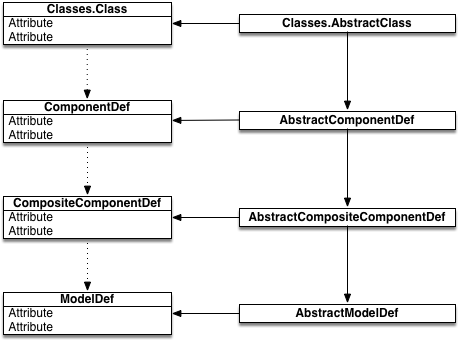Classes.jl
The key feature of the package is the management of an abstract type hierarchy that defines the subclass and superclass relationships desired of the the concrete types representing the classes. The concrete types defined for each class include all the fields defined in any declared superclass, plus the fields defined within the class declaration. The abstract type hierarchy allows methods to be defined for a class that can also be called on its subclasses, whose fields are a superset of those of its superclass.
The Classes.jl package includes the macro, @class, and several exported functions, described below.
The @class macro
The @class macro does all the real work for this package. For each class (say, MyClass) created via @class, the following code is emitted:
An abstract type created by prepending
Abstracton the given class name (e.g.,AbstractMyClass), which is a subtype of the abstract type associated with a named superclass, if given, orClasses.AbstractClassif not specified.A concrete type
MyClass <: AbstractMyClasswith the fields of its superclass plus any locally defined fields.Several methods, including constructors, initializers, and introspection methods.
The 'mutable' keyword
Class mutability is specified by including mutable before the class name, e.g., @class mutable MyClass ... Note that mutability is not inherited; it must be stated in each subclass if mutability is required.
Functions emitted by the @class macro
The @class macro emits
Constructors
"All fields" constructor
This constructor takes as arguments all the fields accumulated through superclasses, in the order defined, and calls
new()on the args. This simply duplicates the default constructor, which is necessary since we define other "inner" constructors and initializers.
Initializers
Initializers are functions that set values on an existing class instance. These come in several forms:
"All fields" initializer
Similar to the "all fields" constructor except that it takes an object that must be a class or subclass of the defined class.
"Local fields" initializer
Takes an instance of the class (or subclass thereof) and initializes only the fields newly defined by the current class. This is provided to support custom initializers that can chain from subclasses to superclasses.
"Superclass copy" initializer
Provided primarily to support immutable classes (but available to mutable classes as well), this initializer takes as arguments all locally-defined fields plus an instance of the immediate superclass of the present class, from which values are copied into a call to
newon the present class.
Reflection methods
isclass(T)Return
trueifTis a concrete subclass ofAbstractClass, or isClass, which is abstract. Returnsfalseotherwise.issubclass(class, superclass)For all superclasses of the newly defined class, a method of
issubclassis emitted that returnstruefor the new class and its superclasses.superclass(class)Returns the superclass of the newly defined class.
superclasses(::Type{T}) where {T <: AbstractClass}Returns a Vector of superclasses from the superclass of class
TtoClass, in order.subclasses(::Type{T}) where {T <: AbstractClass}Returns a Vector of the subclasses for a given class
T.classof(::Type{T}) where {T <: AbstractClass}Computes the concrete class associated with abstract type
T, which must be a subclass ofAbstractClass.absclass(::Type{T}) where {T <: AbstractClass}Returns the abstract type associated with the concrete class
T.
Defining methods on a class hierarchy
To define a function that operates on a class and its subclasses, specify the associated abstract type rather than the class name in the method signature. Since the subclass contains a superset of the fields in the superclass, this works out fine. Subclasses can override a superclass method by redefining the method on the more specific class.
Example:
@class Foo begin
i::Int
end
@class Bar <: Foo begin
f::Float64
end
compute(obj::AbstractFoo) = obj.i * obj.iSince Bar <: AbstractBar <: AbstractFoo, the method also applies to instances of Bar.
julia> foo = Foo(5)
Foo(5)
julia> compute(foo)
25
julia> bar = Bar(4, 3.3)
Bar(4, 3.3)
julia> compute(bar)
16We can redefine compute for class Bar to override its inherited superclass definition. Note that we can use the type AbstractBar, which allows this method to be "inherited" by subclasses of Bar, or we can use Bar directly, in which case the method applies only to this concrete type.
julia> compute(obj::AbstractBar) = obj.i * obj.f
compute (generic function with 2 methods)
julia> compute(bar)
13.2Subclasses of Bar now inherit this new definition, rather than the one inherited from Foo, since the prior class is more specialized (further down in the shadow abstract type hierarchy).
Example
using Classes
@class Foo <: Class begin
foo::Int
Foo() = Foo(0)
# Although Foo is immutable, subclasses might not be,
# so it's still useful to define this method.
function Foo(self::AbstractFoo)
setfield!(self, :foo, 0)
end
end
@class mutable Bar <: Foo begin
bar::Int
# Mutable classes can use this pattern
function Bar(self::Union{Nothing, AbstractBar}=nothing)
self = (self === nothing ? new() : self)
superclass(Bar)(self)
Bar(self, 0)
end
endProduces the following methods:
# Custom constructors defined inside the @class above
Foo()
Foo(self::AbstractFoo)
#
# Methods emitted by @class macro for Foo
#
# all-fields constructor
Foo(foo::Int64)
# local-field initializer
Foo(self::T, foo::Int64) where T<:AbstractFoo
# Custom constructor defined inside the @class above
Bar()
# Custom initializer defined inside the @class above
Bar(self::Union{Nothing, AbstractBar})
#
# Methods emitted by @class macro for Bar
#
# all-fields constructor
Bar(foo::Int64, bar::Int64)
# local-fields initializer
Bar(self::T, bar::Int64) where T<:AbstractBar
# all fields initializer
Bar(self::T, foo::Int64, bar::Int64) where T<:AbstractBar
# Superclass-copy initializer
Bar(bar::Int64, s::Foo)Example from Mimi
The following diagram shows the relationship between the concrete structs and abstract types create by the @class macro. Solid lines indicate subtype relationships; dotted lines indicate subclass relationships, which exist outside the julia type system.

Each class as a corresponding "shadow" abstract supertype (of the same name surrounded by underscores) which is a parent to all abstract supertypes of its subclasses.